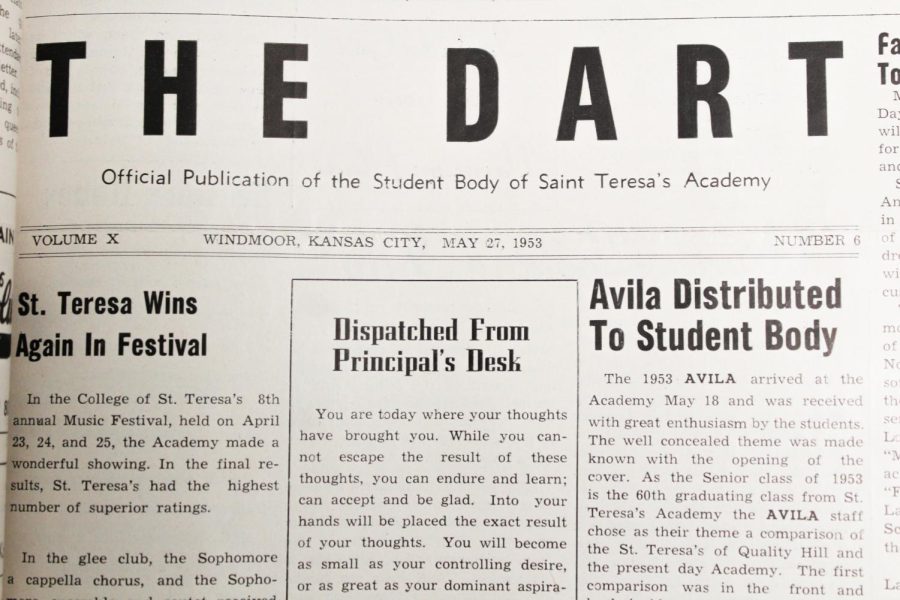The History of The Dart
St. Teresa’s Academy’s newspaper, The Dart, has been the school’s publication for over 80 years, and has touched many students’ lives in that time.
February 10, 2023
This story contains information from the following websites: Our Lady of Mercy Lay Carmelites, the Carmel of the Immaculate Heart of Mary, the Aleteia, the Speakroom, and the autobiography of St. Teresa, entitled “The Book of Her Life.”.
“People looked forward to getting it and seeing what was in it and talked about it,” Lori Burns-Bucklew, STA class of ‘72, said. The “it” is the official news magazine of St.Teresa’s Academy: The Dart, and it’s been a defining feature of STA for many years. The Dart is believed to have been STA’s source for news since 1941, but the origin of its name begins long before that. In 1559, St. Teresa of Avila’s transverberation, or piercing through, took place. According to her journal, “The Book of Her Life,” an angel pierced St. Teresa’s heart with a dart. “I saw in his [the angel’s] hand a long spear of gold, and at the iron’s point there seemed to be a little fire,” Teresa wrote. “He appeared to me to be thrusting it at times into my heart and to pierce my very entrails; when he drew it out, he seemed to draw them out also, and to leave me all on fire with a great love of God.” St. Teresa described the spiritual pain as being so pleasant that she “could not wish to be rid of it” and called it a “caressing of love so sweet which now takes place between the soul and God”. St. John of the Cross elaborated on the event. “It will happen that while the soul is inflamed with the Love of God, it will feel that a seraph is assailing it by means of an arrow or dart which is all afire with love,” John wrote. “And the seraph pierces and in an instant cauterizes this soul, which, like a red-hot coal, or better a flame, is already enkindled. The soul is converted into an immense fire of Love.” After St. Teresa’s death in 1582, her heart was removed, and a wound from the angel’s dart is still visible in the perfectly preserved, which is located in Alba de Tormes in Spain, to this day. In honor of this miracle, the name The Dart was allegedly coined by St. Teresa’s Academy’s newspaper in 1941. The paper’s current logo is that same dart (minus the heart) and different variations of it have existed over the years. Throughout the long history of the paper, many staff members have come and gone, and the paper has evolved, influencing students along the way. Francis Schilling, editor-in-chief of The Dart for the 1955-56 school year, reflected on the publication during her time on the paper, highlighting both differences and similarities between The Dart of the ‘50s and the current publication. The Dart at the time wasn’t a class, but an extracurricular activity, worked on after school instead of during the school day, and subscription cost one dollar, as opposed to the free distribution of current day. “It was a big deal when the paper came out. I had newspapers from when I was a freshman, sophomore, junior [and] senior,” Shilling said. While the paper currently has three editors-in-chief, during Schilling’s time on staff it only had one, leaving her with several important duties. “Probably what I did the most was proofreading,” Schilling said. “We made up a dummy paper on big sheets of paper, and when we got it all the way we wanted it and everything fit, I would drive this to the printer.” Burns-Bucklew, editor-in-chief of The Dart in 1972, also remembered getting issues of the publication printed. “We used the Westport printer company which was over on 43rd and Broadway. They had these big machines and [the issues] would literally come rolling out and smell like ink,” Burns-Bucklew said. Burns-Bucklew also recalled an alternate task, issued by the moderator at the time, Sister Marie Tucker. “The one thing that I remember most was having to sell advertising. Sister Marie Tucker made us sell advertising and it was mortifying,” Burns-Bucklew said. “I was really shy.” Aside from Schilling’s editor role, other staff positions during her time on The Dart included business manager, features editor, circulation manager, make-up, and reporters, each coming with their own tasks. “Our reporters gathered information, but we were not allowed to talk in the halls…so we did all of that after school and maybe call[ed] people on the phone to talk to them and get information,” Schilling said. Another role was typists, a job now rendered unnecessary due to the use of computers for stories and layouts. “We had typists,” Schilling said. “That was one of the jobs, people who typed it up.” Of course, the role of writing remains central to any publication, and things were no different during Schilling’s time at the school. Both then and now, writers have worked to represent as many students in the paper as possible. “We had some good writers. There was a gossip column for instance, and that was a good way to get people’s names in,” Schilling said. Burns-Bucklew recalled a similar goal. “One of our challenges that Sister Marie gave us was to try to mention everyone in our class at least once in our senior year,” Burns-Bucklew said. Burns-Bucklew’s stint on The Dart contained unique challenges due to the Vietnam War. The paper during her time wrote about student activism surrounding the war, which went against the school dress code, as some student protests involved wearing black armbands. “It was a time of great social unrest,” Burns-Bucklew said. “There were a lot of protests against the Vietnam War. I believe it was that spring that people were wearing black armbands.” Of course, Burns-Bucklew and her peers covered lighter topics as well. She marked writing movie reviews as one of her favorite tasks. “There was a movie called ‘“Friends”’ about teen love and then of course, there was the Franco Zeffirelli ‘“Romeo and Juliet”’ that came out that year,” Burns-Bucklew said. Schilling recalled the environment of her time on The Dart, remarking fondly on meeting with her peers. “When we would have meetings, there was a lot of laughter, a lot of kidding, a lot of jousting back and forth, except we really got it done,” Schilling said. Burns-Bucklew also remembered the process of putting the paper together, remarking on particularly loving writing headlines. “In between deadlines, we were constantly working on it. The printing process was called offset printing. Of course we didn’t have any kind of electronic technology, so it would be printed in long columns just like the columns you would see in the newspaper, and then we cut them to size and laid them out for each page,” Burns-Bucklew said. “Then we did the headlines separately. That was one of the things I really liked doing was writing headlines.” Schilling’s stint as editor-in-chief taught her lessons that she carried into both her career as a teacher and larger life, such as attention to detail. “When you go on to college and get a job [and] your boss wants you to do X, and you pay attention to detail and do it correctly, it works better,” Schilling said. “It sounds like a little thing, but I found that to be very important in my life.” Burns-Bucklew used writing skills acquired from The Dart in student journalism after STA and her career as an attorney. “In college I worked on the student newspaper at Penn Valley. After I left, I went to Rockhurst College for a semester and wrote a couple of articles for [that] paper. Then I got an internship in Public Relations at Midwest Research Institute,” Burns-Bucklew said. “I was writing for their internal newsletter and then learned a little bit about public relations and writing. And writing skills are important in my work now. Sometimes [I] have to track down information and research things.” She also remarked on the effect of The Dart on students in general, commenting on an improved understanding of politics. “I think that [being on The Dart] starts a habit of being attentive and being aware of important issues around you. Student publications can help people understand politics,” Burns-Bucklew said. “[In] a small school like St. Teresa’s, I think it’s an important communication tool.” This attitude continues in the present, as The Dart shapes student life at STA. The paper has impacted students at St. Teresa’s Academy for over 80 years, and will continue to do so for many more. Nothing could have summarized The Dart’s importance better than the 1970 Teresian: “High school newspapers are usually received with polite indifference by anyone outside the school circle. St. Teresa’s has a proud exception in The Dart…The Dart would be a credit to any school large or small.”




